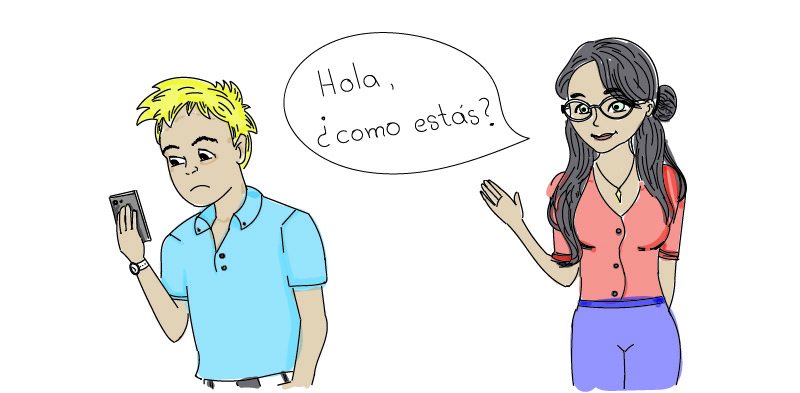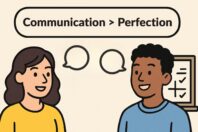Language Learning is Broken, And Software is Making it Worse

Get our free email course, Shortcut to Conversational.
Have conversations faster, understand people when they speak fast, and other tested tips to learn faster.
More infoImagine you have a friend who doesn’t speak any Spanish. They have decided to start learning, and they ask you for advice on how to do it.
You’d probably give them an app to try. “I heard Duolingo is good. Or maybe Rosetta Stone? That’s good, if you can afford it, right?”
There are millions of people learning languages using an app now. It’s become the defacto way to do it. And while in some ways it’s a major improvement over archaic, academia-driven language classes, it’s broken.
These apps call themselves “free language education for the world”. They are lauded by the press for “changing the face of language learning”. But is this a good thing? But are they actually effective?
How many people do you know that have successfully learned a language to fluency using apps? Using just a computer?
You recommend Duolingo (or some other language learning software) to your friend, but you’ve just shot them in the foot.
Because while it’s easy and free to get started, it ultimately won’t get them where they want to go.
Because you’re missing something.
The Undeniable Necessity Of…
… real people.
Introducing the most advanced technology the world has ever seen. Features include:
- impeccably accurate voice-recognition, with no annoying errors
- state-of-the-art pronunciation feedback
- infinitely interesting and engaging, with hundreds of millions of different versions to try
- built-in accountability
- adjusts automatically to your level, pushing you just enough
Introducing… humans.
Language is about people.
Language is about communicating.
Language is about having real conversations.
Language is about connecting with a culture.
But even if those weren’t true, the fastest way to learn a language to actual fluency would still be spending as much time as possible speaking and having conversations with real people.
Learning Spanish is like any other skill.
It’s not a mental exercise, it’s not a list of things to memorize and spit out.
No, learning Spanish is like any other skill in that it is fundamentally built on practice. On quality hours doing what you want to be able to do (no matter if it’s done poorly initially).
All the little fill in the blank, click the picture, multiple choice bullshit you’re doing in that app is training you to be good at THAT. But it’s not going to help you much when you need to actually turn around and open your mouth to have a real conversation with a real person in Spanish.
If you want to be able to speak Spanish, you actually have to SPEAK Spanish.
I know this both from experience and from helping thousands of Spanish learners.
A Story
I have a good friend. We’ll call him George.
George had been using Duolingo for two years, diligently doing a little bit every single day. He’d long finished the entire curriculum. George then moved to Medellín, Colombia for a few months.
When George arrived, on paper, he knew almost as much, if not more Spanish than I did. He certainly knew more grammar, and could probably crush me in a written test.
But guess what? He spent his entire time using Spanish language learning software, and almost no time talking to real people. And when he arrived in Colombia, in a real, Spanish-speaking country, he couldn’t actually have conversations.
He could handle the basics, and that’s about it – because he had never practiced actually speaking and understanding a native speaker in the real world.
So, when he arrived, he took my advice, and started speaking a lot. And within two months, he had a local girlfriend and a circle of Colombian friends, most of which spoke little or no English at all. People he never would have connected with if he didn’t actually speak Spanish – if he had only ever used software.
I’ve seen this over and over.
At this point, you’re probably in one of three situations:
- You’ve been using software to learn Spanish for awhile already, and haven’t spoken much
- You haven’t really gotten started yet
- You already have a decent level but can’t seem to break through to the next level of fluency
Here’s what to do in each situation. Read them all, as there’s nuggets of wisdom useful across all situations in each.
1. You’ve been using software to learn Spanish for awhile already, and haven’t spoken much
Guess what? At this point, if you’ve read this far, you probably think you’re screwed. That you chose the wrong way to learn Spanish, and it’s game over, since, ya’know, you haven’t actually been speaking.
Wrong.
In fact, you have a head-start. Let me explain.
All of that work you’ve done learning via software hasn’t prepared you to have an actual conversation. But what it has given you is a basic understanding of the langauge, and a bank of vocabulary.
These are things you know academically, but aren’t currently able to use in a real conversation yet. But you know them.
All that means is your progress, once you start speaking, will be faster. You won’t need to “learn” everything, you’ll just need to practice it in a real conversation so that you can free it from the academic written-only reigns and be able to use it freely in speech.
In fact, that’s exactly how I go about learning vocabulary – I memorize words using a flashcard SRS, which puts them in my memory. At this stage, it takes me between a split second to a few seconds to remember the word. But it’s in there. Now, I just use it a lot in real conversations. Once I’ve used it for real many times, I don’t have to think about it anymore – it just flows like English words.
The same thing will happen for you once you start speaking a lot. You’ll slowly take the things you know intellectually and through real practice in real conversations, make those things come out naturally.
It’s pretty magical once you’ve experienced it – and only speaking will get you there.
2. You haven’t really gotten started yet
It’s your lucky day.
Since you haven’t even started yet, this post will save you a TON of time screwing around with apps.
To get rolling, you’ve got two equally good options:
- Start speaking right away (I’ll cover how to do this in a bit)
- Use an app to get started.
Whaaaaaat?!
Didn’t I just spend this entire post talking about why NOT to use a language learning app?
Relax, let me explain.
This route is for people who have a hard time getting started with things. Because apps are so easy and low-friction, you can get rolling right away, while you work on finding people to talk to (I’ll cover that in a minute).
Here’s how to do this: I want you to download the Duolingo app, or go to their website, and spend two hours on it.
Do as much as you possibly can in those two hours. Really focus.
Done with those two hours? Delete your account.
The fact is, these apps are actually very good for learning the “super basics” of any language. I’m talking things like, “I”, “my dog”, “it is a red apple”.
Once you can make the most rudimentary of sentences, like “that is a white dog” (if even that complex), these apps become a waste of time. But they are almost as good as speaking with a teacher for this first “super basics” stage.
But seriously – after two hours (more than enough to learn the super basics of Spanish), delete the app.
Now, start speaking.
3. You already have a decent level but can’t seem to break through to the next level of fluency
I bet you know what’s coming, don’t you?
Yep.
Speak more.
At this level, you probably have a pretty strong grasp on a lot of grammar. You know it intellectually, but you still have to think about it when talking to people. The only way to push through that is to practice those concepts in real conversations.
That’s my general strategy when it comes to grammar – learn a little bit of new grammar, then practice the hell out of it in real conversations until it comes as naturally as “tengo que estudiar”. Repeat with new concepts and conjugations.
You can’t skip the practicing in real conversations part. This constant iteration is how you get to the next level. (It’s also only at this point that you want to get people to correct most of your little mistakes.)
There is no replacement for practice in a real conversation. All the people ignoring this fact, using just apps to learn, are handicapping themselves.
OK, so you’re convinced, but…
Where do I find people to speak Spanish with?
You’ve got four basic options:
- have friends who are native speakers and are willing to use it with you
- do a language exchange
- get a private tutor
- use BaseLang
1. Using friends
This is a great option – it’s the very reason you’re learning in the first place, and at the advanced stages, will make up the vast majority of your speaking.
But, the issue here is you don’t want to be hanging out with a friend, practicing, and then stop them in the middle of the conversation, “hey, what was that conjugation you just used? Can you explain that tense to me?”
You don’t want to be hanging out and then have to bring things to a halt to ask someone to explain stuff to you. So while this is good to practice stuff you already know, it’s not the place to learn new things.
2. Language exchange
Another free way to speak a lot is using a language exchange through a myriad of different websites. A language exchange is where you spend half the time in English, and the other half in Spanish.
And that’s the first problem. Right off the bat, you’re doubling the amount of time it takes to get an hour of speaking practice. If you’re busy like most people, this is a non-starter. It’s the main reason I didn’t use exchanges when learning Spanish.
But there’s another issue.
Like you, the other person in the exchange isn’t a teacher. They are just a native speaker trying to improve their English, just like you are trying to improve your Spanish.
And this means that they are probably terrible at explaining things. Most explainations end in, “I don’t know, that’s just how it is.”
Don’t believe me? What’s the difference between “may” and “might”? Or, why do we say “big, red house” and not “red, big house”? I couldn’t tell you. I have no idea. “That’s just how it is.”
This is why you want a teacher. Someone who is actually trained in teaching Spanish, in how to explain things, who knows the why so they can explain it to you in a way that makes sense.
3. Hire a teacher
So that’s your third main option: hire a teacher to help you, one-on-one (group classes are a waste generally, as the point is to have to speak, and when you’re in a group you don’t have to and don’t have as much opportunity to – among other issues).
The right teacher is your biggest asset, by far, in learning Spanish. There’s a reason that when I learned Spanish to a conversational level in a month (documentary about that here), I made three hours of private tutoring per day the bedrock of my program.
A good teacher will know when to correct your mistakes, and when to let them slide. They will be amazing to practice with, since they can keep the conversation going and steer it to topics where you can practice what you’ve just learned. They can explain new concepts clearly so you just “get it”.
Unlike software, if you get confused, they can walk you through something until you get it. They can fix your pronunciation, help your listening so that you can understand people when they talk fast, and so much more.
If you’re looking for the biggest learning-per-hour punch, an amazing private teacher is the only way to go.
The only issue is, they can get expensive. And expensive fast.
In fact, I spent $1,350 in one month on my tutor alone. That’s a LOT of money. Most people can’t do that. It’s too much, so they have to use slower, inferior, free options (like apps that don’t work).
That’s exactly why we built BaseLang.
4. Use BaseLang
At BaseLang, we offer unlimited Spanish tutoring for $179 a month.
Now, let me be clear upfront – I don’t care if you use BaseLang. I care that you SPEAK. If that’s with some other method, I’m cool with that. I want you to speak, however you go about it – whether that’s with us or not.
That said, if you’re serious about learning Spanish, and you agree that speaking with a teacher is the most important thing, than there really isn’t any option that comes close to BaseLang (in quality, and especially in price).
Our teachers all have degrees in teaching Spanish, so they understand how to teach and explain things. They’re all super friendly (if we wouldn’t have a beer with them, they don’t get hired). Most important, they are focused on communication and follow our heavily optimized curriculum (which gets personalized to your goals, interests, and weak points) that cuts out all the irrelevant, un-useful fluff that fills most textbooks and apps and gives you the stuff you actually need to communicate in real life first.
Remember George? He knew he needed to speak, but other options were too expensive. So he used BaseLang.
You can get started here – your first week is just $1 and you can cancel at any time with two clicks if you don’t love it. Or for more info, click here.
But let me reiterate – I don’t care if you use BaseLang. I know it’s the best way to go about speaking a lot (because that’s how we built it), but what I really care about is that you SPEAK. However you go about it.
Because at the end of the day, language learning software will not get you where you want to go.
If you want to speak Spanish, you need to actually speak Spanish.
Ready to actually speak? Get a free 30 minute class with a BaseLang teacher.
Share this post publicly on Facebook, and tag the BaseLang FB page in your post, and we’ll give you a free 30 minute class. One class per person per article or video. Details.


